![[Metroactive Arts]](/arts/gifs/art468.gif)
[ Arts Index | Silicon Valley | Metroactive Home | Archives ]
Notorious C.H.O.E.
David Choe's art is so provocative he gets death threats and gallery offers. Now that's talent.
By Todd Inoue
NOON IS a dangerous time to visit an artist. Knock on the door of David Choe's combination art/living space near San Jose's Japantown, and the artist greets you with bedhead, stained fingernails and gravel voice.
Scattered around the space, which he shares with two roommates, artwork in various stages of production lies in piles. I see a stack of goofy whales drawn on sticker paper; a collection of distorted faces is pinned on the wall. Unfinished pieces--brilliant abstract figures awash in watercolor, acrylic, aerosol and Liquid Paper--lean on easels. Choe's style alternates between rebellious and breathtaking on the same canvas. Think Manet and Twist kicking it on Christopher Doyle's couch; think Wong-Kar Wai if the Hong Kong director went punk rock and directed Style Wars.
Choe's sketches ooze adrenaline, as if dashed off in the throes of creative chaos. He takes a street art aesthetic and tweaks it to fit his tastes and humor. He'll reinterpret the Mona Lisa and give her breast implants, or create a watercolor of Katie Holmes from Dawson's Creek. Reading his amazing adventures in Giant Robot, his self-published zine Slow Jams and his first book, Bruised Fruit, gave me the impression of a cocky, trash-talking, fearless risk taker. In person, Choe is definitely all that, but a nice cocky, fearless, trash-talking risk taker, armed with paints and brushes.
Japanese action figures, comics, magazines, books and more unfinished works of art litter his bedroom floor. A mural covers one wall; the other three display snapshots, a world map and the works of his friends. A four-track recorder, an electronic drum kit and two guitars sit at the foot of his bed.
The world map is by far the most ordinary thing in his room but also the most telling. Choe's traveled all over the globe, including Gaza City, the Congo, Bosnia and Vietnam. He's thumbed and train-hopped his way across America. He has lived in many places, but he says he likes San Jose the best.
His girlfriend, MyLan, lives close by. He doesn't have to worry about his car or apartment getting broken into anymore. It's odd when you think about San Jose's lack of eye-appeasing architecture and scarce art scene, but for Dave, who's lived nine deep in an East Bay apartment, ask not what your city can do for you.
"When you live in a place like San Jose, where shit's not really happening, it's up to you to make the shit go down," he says. "You can go to the party and mingle, or you can throw the party and blingle."
When he was a child, his family moved all over L.A., from Koreatown to Beverly Hills, and Orange County. David was always drawing, spending his allowance on comics. His father, Jimmy, was an accomplished illustrator in Korea. When Jimmy returned home from a required stint in the Korean Army, his parents tore up his paintings, telling him to give up the dream of being an artist so he could support his family. Jimmy went to law school but found work as a factory worker before moving the family to the United States.
"My dad never got to pursue his stuff," Choe says. "When I go back and look at his sketchbooks, I think, if he was born at a different time and with the right opportunity, it'd be me and him going toe-to-toe."
His parent's real estate business got burned down in the 1992 riots (David claims he was the sole Korean looter, calling the L.A. riots "the best night of my life"). Choe grew sick of the racist and apathetic attitudes that his family experienced. Art became a conduit not just for creativity but also for rage. As a teenager, Choe stole, shoplifted, broke things, caused chaos and exacted revenge via aerosol.
"It was this internal desire [born] of being sick of everything you see," Choe recalls. "You just get angry. You're pissed off because nobody likes you. Why the fuck do these kids who are bratty and such shits get to drive better cars than my parents? I'm saving up allowance to get one Star Wars figure when they have the whole armada."
After graduating from high school in 1996, he went on a two-year world tour. He hung out with Jews and Arabs in Gaza City. He almost died when he got lost in a Congo jungle for two weeks. He jumped trains and snuck on airplanes, all the while keeping hypnotic diaries. When he returned from his adventure, he attended California College of Arts and Crafts in Oakland, dropping out after two years. He stole art supplies and books, and robbed every frat house in Berkeley before getting caught and doing a week in lockup.
"I went to jail and I never ever want to go back," Choe says. "You'd have to fucking kill me to go back. It wasn't even prison, it was a holding cell. We got caught on a Friday and wait the whole weekend and we had to wait a few more days. You feel crazy. It feels so claustrophobic having your freedom taken away from you. Three of my friends got caught and one turned Muslim after that. It was a life changing experience for all of us."
Despite the constant drama, his work thrived. He returned to L.A. and got breaks in the pages of Hustler, Raygun, Vice and Juxtapoz. An art exhibit at a Double Rainbow ice cream parlor on L.A.'s trendy Melrose Avenue stayed up for a year, leading to background jobs in the movies 8MM and Glass House, for which he drew all of Leelee Sobieski's art.
His work causes intense reactions. The couple name-checked in his amazing first-person narrative Slow Jams, about a crush that ends violently, are threatening a lawsuit. Another guy featured in the Giant Robot Congo travelogue--a German tourist with jungle fever who is now a government official--threatened to off him and his family.
"I've had my stuff called supercontroversial because there were no white people in it," says Choe, referring to his "farewell to L.A." mural thrown up on a fountain near the Sunset Strip. "Which is shocking to me. There's one or two white people in this huge crowd scene. The manager wanted me to white out some of the faces and I said, that is not going to happen.
"People ask me if I paint [minorities] on purpose and it's not even conscious," Choe says. "White people feel more comfortable around white people. I feel more comfortable around minorities. I paint what I see. In the morning I wake up and look in the mirror, I see a Korean face not a white face. I paint what's close to me. All I portray is my life, my friend's lives, my parent's lives. I do what I do and if that's going to get me in trouble, whatever."
Choe is the subject of a documentary, a collaboration between USC filmmaker Harry Kim and 5 Color Cowboy's Johnny Granado. A portion of the doc (online at IFilm.com), called Whales and Orgies, captures Choe recklessly tearing up L.A., ninja style. Choe spits out reclining nude figures, wisdom-spouting whales, stylized faces and blunt Ice-T lyrics. He works quickly and feverishly, during one sequence leaning out of a car and spray painting a huge whale on a Highway 101 sound wall during rush-hour traffic. He finishes the mammal off with the tagline "Take the bus."
He remains unrepentant, justifying graffiti as a response to the malaise of crass billboards. "I have no remorse about the graffiti shit, because I'm not a property owner," Choe declares. "What gives corporations the right? Say I don't want to see that ad, but I have no choice because it's 20 feet high. And why? Because you paid for it? That's the appealing part of graffiti and comics--[they're a] kind of instant media."
One of David's most inspired pieces is a permanent fixture inside 5 Color Cowboy hair salon on the Alameda. Covering the entire north wall, 18 feet high and 48 feet long, is a surreal street scene that mixes New York City and Hong Kong skyscapes. One girl perches on a paint-mask strapped donkey and another rides a hippo. A huge robot is the dominant figure, with freeways and overpasses shooting through. The piece is flecked with gold paint detailing and quips written in English, Korean and Arabic.
"Dave's art is an integral part of the place," says Granado. "It's been up a year and a half, and every single time someone sees it, even longtime clients, they say, 'Did he do something different?' A lot of artists do one-dimensional stuff. Dave's art is multilayered and people still react. It'll never get old."
The 5 Color Cowboy piece helped soothe one of Choe's most ravaging setbacks. While still in Los Angeles, he got the call--he sold a pair of pieces for $40,000 and $23,000 to a couple in Marin. He didn't have enough money to pay $800 shipping so, planning to move to Oakland anyway, he packed up his flatbed truck, strapped the two art pieces down and hit the gas. Somewhere on the Grapevine, he checked his rearview mirror and saw flailing rope. The pieces were gone, evaporated in the musty night air. Still shattered from the loss, Choe finished the long, sobering drive up to the Bay Area. He reticently broke the news to the couple and offered to paint two brand new pieces or exchange for smaller ones. The disappointed couple turned him down and he hasn't heard from them since. It took him weeks to get over the loss, and in the aftermath, he threw himself into his work with a new passion. The mural inside the 5 Color Cowboy hair salon honors the lost highway pieces. It's a ridiculous journey by spray can as well as a breathtaking phoenix that rose out of ashes.
"I didn't have any idea what I was going to paint," Choe explains. "It just started with the shapes. When it started to look like something, that's when the elements came together. I still had that pent-up anger from losing those paintings. I had freeways and wood chips that came out unconsciously. I had so much energy and went through it in two and a half weeks. For the most part, I don't have any idea what I'm doing but people and buildings are my favorite [things to draw]. I treat buildings as if they're actual people."
Tonight, Choe doesn't feel like drawing whales or buildings or touching up someone's fence. On a patio table, he spray paints face after face onto large pieces of sticker paper, using a can of flat-black Krylon. His arm moves swiftly and cleanly, taking no more than 30 seconds per face. He also makes aliens, robots, ninjas and ghostlike apparitions.
Later, he'll cut them out and use some for the upcoming exhibition and others for late-night bombing runs. He praises the city's graffiti task force quick response; most of his work is pulled down or painted over within 24 hours. It surprises him that they go to so much trouble, though, because he tries to add context to public defacement. If, for instance, he hits a Goodwill truck, he'll draw a whale with the words "Donate" coming out of its mouth.
He plans to fill his upcoming Gallery AD solo show with remnants from Dave's world. He's creating a mural for the exhibit, and he will display large and small pieces, including delicate clay figurines and dioramas. There will be lots of swag--Bruised Fruit books, 2003 calendars, whale stickers--for sale. He will also perform a set with his Korean drumming group, KGB (Koreans Gone Bad), and DJ Matthew Ro.
Choe is currently working on three books and one comic book, and weighing other job offers. He's been extremely productive since landing in San Jose seven months ago, so pardon him if he looks groggy and droopy-eyed around lunchtime.
"I might wake up at noon but, fuck, that means I've been up until 6am painting, scheming, plotting and planning," Choe tells me. "I just want to be the best artist I can be for my parents, for me, for anyone."
[ Silicon Valley | Metroactive Home | Archives ]
Copyright © Metro Publishing Inc. Metroactive is affiliated with the Boulevards Network.
For more information about the San Jose/Silicon Valley area, visit sanjose.com.
![]()
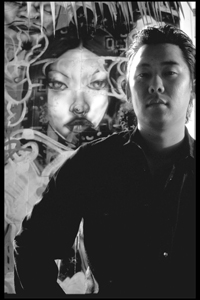
Photograph by Santi Suthinithet
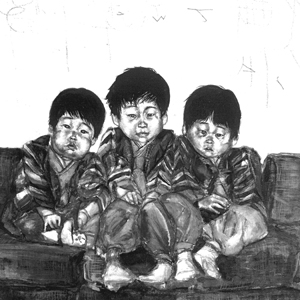
The Art of Choe: 'Choe Bros circa 1981' (mixed media)
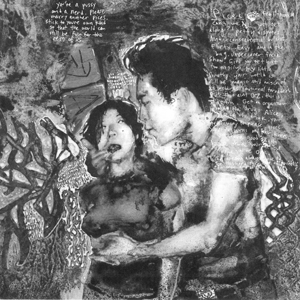
Adrenaline Rush: Many of Choe's sketches look as if they were fashioned in a rush of creative chaos: 'I Fuck Nerds' (mixed media).
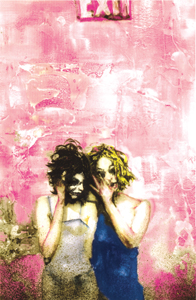
Manet With a Twist: Choe's pieces often alternate between rebellious and breathtaking on a single canvas; pictured is 'Exit' (mixed media).
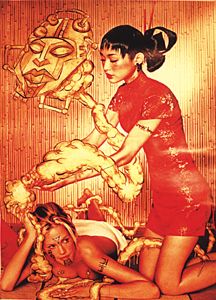
Krylon Commando: Snippets of advertising art often appear in a surreal new context when Choe is through with them. Pictured is an untitled piece utilizing a Skyy Vodka bus stop poster.
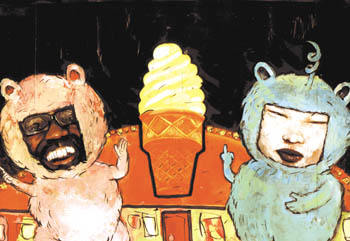
Choe Is Me: The artist plans to fill his upcoming Gallery Anno Domini show with a mural and several pieces that haven't been shown before, including clay figurines and dioramas; pictured: 'Ice Cream Nerds' (mixed media).
A reception celebrating David Choe's solo show will be held Friday (Feb. 7) at 8pm at Gallery Anno Domini, 150 S. Montgomery St., San Jose. The exhibit will stay up until Feb. 28 and can be viewed by appointment by calling 408.271.5151.
Send a letter to the editor about this story to letters@metronews.com.
From the February 6-12, 2003 issue of Metro, Silicon Valley's Weekly Newspaper.